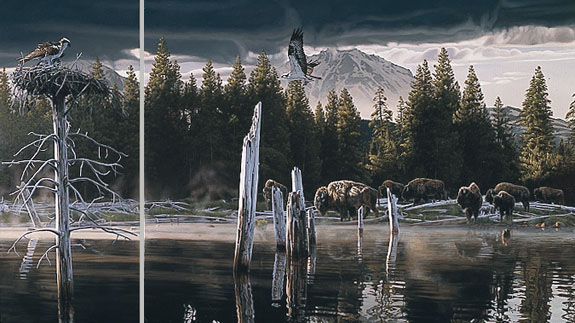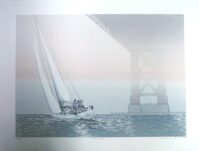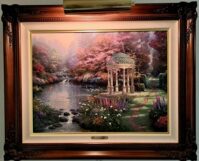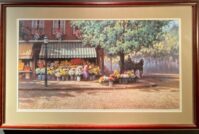AN EARLY LIGHT BREAKFAST (DIPTYCH) by Rod Frederick-Consignment
$245.00
2 in stock
Description
AN EARLY LIGHT BREAKFAST (DIPTYCH) by Rod Frederick Limited Edition of: 1750, Image Size: 23 7/8″w x 18″h. Published: November 1992
“There are two stories happening in this scene. One is the osprey nest and the other is in the forest where the bison are standing. By creating a diptych, I can keep the two animals separate, but still together in their habitat, which is the way they actually live.”The tall, thin left side of the diptych has the female osprey standing on the nest. The wider panel on the right has, in addition to the bison, the male osprey flying with a fish in his talons, delivering it to the babies in the next painting over.
“It is definitely a summertime scene. The ospreys have returned to the north to nest not that the ice has melted off the high mountain lakes. The osprey is one of the most widespread raptors in the world. They’re found on most continents, but they can winter only in areas where lakes are ice-free because they feed exclusively on fish. The bison used to be as widespread as the osprey, but bison were more easily and thoroughly hunted. I symbolize that by having the ospreys in the light, but the bison just coming out of the shadows.”
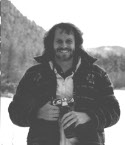 |
Rod Frederick has grown up with animals…. from a menagerie of pets that populated his boyhood home, to a combination biology and fine arts degree in college. Born in Salem, Oregon, Rod Frederick grew up in Portland. Artistic influences shaped Rod Frederick’s boyhood – his mother had a degree in fine art, and his father, a lawyer, spent weekends at the easel. The Frederick household was always full of various animals, so it was entirely natural for Rod to combine his interests in art and animals into a career as a wildlife artist.
Rod Frederick attended Willamette University, majoring in art and minoring in biology. Standing six feet, four inches, Rod Frederick also found time to play forward for the university’s basketball team. After completing his schooling, Rod Frederick accepted a variety of commissions that led him to paint classic scenes of the Northwest. Barns, covered bridges, mountains, fields and ponds became the focal point of Rod Frederick’s art, but gradually he worked more and more wildlife into his paintings.
Today Rod Frederick’s career is wildlife art. And Rod Frederick still has a house full of pets. Only Rod Frederick now goes beyond the domesticated variety to seek out wildlife in its natural environment: in the mountains, high above the timberline; in the forest that cover the Northwest; in streams and ponds where wildlife of all forms congregate.
Rod Frederick’s curiosity about animals and his own dedication to realism dictate the way he works: devouring every source of reading material about a particular species; photographing and sketching; and devoting large amounts of time to research in the field. Rod Frederick finds his favorite environment in the mountains, above the timberline, because “the open spaces are exciting. I have a chance to ‘get away’ and perhaps get a glimpse of my favorite animal, the mountain goat.”
“People tell me they like the natural colors and mood I create in my work,” Rod Frederick says. “They say it’s very realistic, and that’s what I’m looking for.”
Rod Frederick lives in Oregon, where he has an inspirational view of the Cascade Mountains right outside his window. Rod Frederick uses oils and gouache to paint his wilderness scenes. Rod Frederick is featured in the book: The Best of Wildlife Painting (North Light Books, 1997).
Rod Frederick is always ready to travel in search of new subjects. “Often,“ Rod Frederick says, “I’ll look for a particular species, and what I’ll see is something totally unexpected. The unpredictability of seeing animals in the wild is exciting – it’s what I call “planned unpredictability.” When you do see what you’ve planned to see it’s serendipitous.”
